History
All the main Venetian theatres were owned by important patrician families; combining business with pleasure in the Italian city with the most crowded and competitive theatrical culture. When most opera in Europe was still being put on by courts, "economic prospects and a desire for exhibitionistic display", as well a decline in their traditional overseas trading, attracted the best Venetian families to invest in the theatre during the 17th century. [1] Europe's first dedicated public and commercial opera house was the Teatro Tron from 1637.
The Grimani, with whom the Vendramin often inter-married, were dominant, owning what is now called the Teatro Malibran, then called the Teatro San Giovanni Grisostomo, as well as the Teatro San Benedetto and other houses. The Veniers owned La Fenice, still the main opera house.
Teatro San Luca
The Vendramin owned the important Teatro di San Luca or Teatro Vendramin or Teatro San Salvatore, founded in 1622 in the San Salvatore, or in Venetian dialect San Salvador district, later renamed the Teatro Apollo, and since 1875 called the Teatro Goldoni, which still thrives as the city's main theatre for plays, now in a building of the 1720s. [2] The Teatro San Luca was rebuilt in the 1720s and renamed the Teatro Apollo. This building survives today. [2] In the age of Carlo Goldoni, the greatest Venetian dramatist, only the San Luca and the Malibran still put on spoken drama, and his desertion of the Grimani for the Vendramins at San Luca in 1752 was a major event in the theatrical history of the period, ushering in perhaps his finest period, in which as well as his comedies, he played a significant role in the development of the opera buffa. [3] The Vendramins, who had considerable direct involvement in the management of the theatre, had a sometimes uneasy relationship with him, arguing over money and the style of his plays, until he left for Paris in 1761, as a result of a dispute with his rival, Carlo Gozzi. However the Vendramin did not take their involvement as far as Vincenzo Grimani, who was a cardinal and opera librettist.
The theatre had many changes and renovations due to fire or structural failures. Among them the most important was by architect and set designer Giuseppe Borsato in 1818, and the redecoration of the rooms by Francesco Bagnara, then art director at La Fenice in 1833. In 1826 the theatre had been the first in Italy to install gas lighting. It is a traditional 18th Century Italian theater, with an auditorium in four tiers of boxes and galleries, with a total capacity of 800 seats. The stage is 12 metres (39 feet) wide and 11 metres (36 feet) deep with an iron lattice.
Teatro Goldoni
In 1875 during the celebrations of the birth of the playwright the theatre was renamed the Teatro Goldoni at the instigation of Angelo Moro Lin] with the backing Regina De Marchi widow of the Vendramin family.
Teatro Stabile del Veneto "Carlo Goldoni"
The theatre remained in the hands of the descendants of the Vendramin until 1957. The archives of the Teatro Vendramin', now held in the museum that was Goldoni's house, are increasingly being used by historians. The theatre was closed after the Second World War because it was unsafe, and dispossessed in 1957. After a lengthy restoration and renovation to improve capacity and services it reopened in 1979. The first performance was La Locandiera by Goldoni.
The theatre is home to a prose season organized by the Teatro Stabile del Veneto "Carlo Goldoni", as well as children's theater, opera, concerts, ballets and other events.
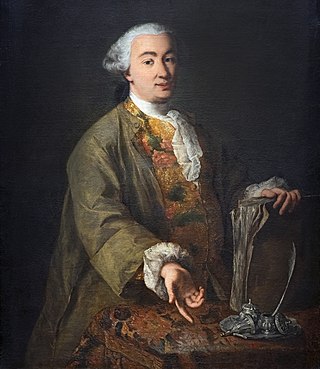
Carlo Osvaldo Goldoni was an Italian playwright and librettist from the Republic of Venice. His works include some of Italy's most famous and best-loved plays. Audiences have admired the plays of Goldoni for their ingenious mix of wit and honesty. His plays offered his contemporaries images of themselves, often dramatizing the lives, values, and conflicts of the emerging middle classes. Though he wrote in French and Italian, his plays make rich use of the Venetian language, regional vernacular, and colloquialisms. Goldoni also wrote under the pen name and title Polisseno Fegeio, Pastor Arcade, which he claimed in his memoirs the "Arcadians of Rome" bestowed on him.
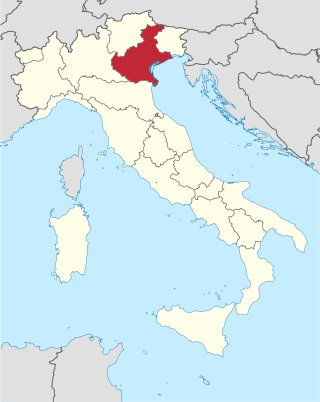
Veneto or the Venetia is one of the 20 regions of Italy, located in the north-east of the country. It is the fourth most populous region in Italy, with a population of about five million. Venice is the region's capital and the largest city.

Carlo, Count Gozzi was an Italian (Venetian) playwright and champion of Commedia dell'arte.
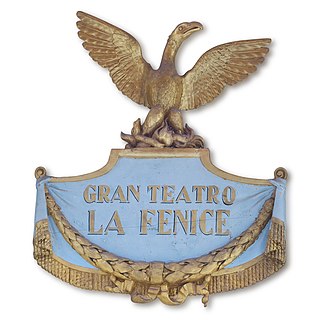
Teatro La Fenice is a historic opera house in Venice, Italy. It is one of "the most famous and renowned landmarks in the history of Italian theatre" and in the history of opera as a whole. Especially in the 19th century, La Fenice became the site of many famous operatic premieres at which the works of several of the four major bel canto era composers—Rossini, Bellini, Donizetti, and Verdi—were performed.
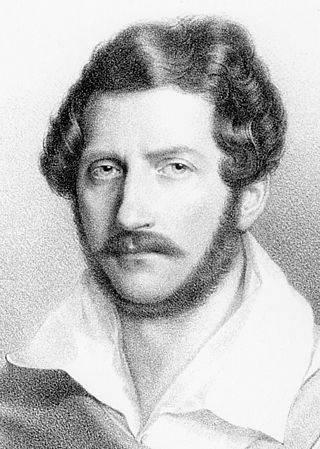
Pia de' Tolomei is a tragedia lirica in two acts by Gaetano Donizetti. Salvadore Cammarano wrote the Italian libretto after Bartolomeo Sestini's verse novella Pia de' Tolomei, which was based on Canto V, vv. 130–136 from Dante's narrative poem The Divine Comedy part 2: Purgatorio. It premiered on 18 February 1837 at the Teatro Apollo in Venice.

The House of Grimani was a prominent Venetian patrician family, including three Doges of Venice. They were active in trade, politics and later the ownership of theatres and opera-houses.

The Teatro Malibran, known over its lifetime by a variety of names, beginning with the Teatro San Giovanni Grisostomo after the nearby church, is an opera house in Venice which was inaugurated in 1678 with a production of the premiere of Carlo Pallavicino's opera Vespasiano. By 1683, it had quickly become known as "the biggest, most beautiful and richest theatre in the city" and its operatic importance throughout the 17th and 18th centuries led to an even grander description by 1730:

The House of Vendramin was a rich merchant family of Venice, Italy, who were among the case nuove or "new houses" who joined the patrician class when the Libro d'Oro was opened after the battle of Chioggia. Andrea Vendramin served as the sole Vendramin Doge from 1476–78, at the height of Venetian power, though in 1477 an Antonio Feleto was imprisoned, then banished, for remarking in public that the Council of the Forty-One must have been hard-pressed to elect a cheesemonger Doge. In his youth, Andrea and his brother Luca, in joint ventures, used to ship from Alexandria enough goods to fill a galley or a galley and a half, Malipiero recorded in retrospect: even his factors grew rich managing his affairs. At this period, mentions of Vendramins in various fields of business occur; Luca Vendramin (d.1527) founded a successful bank on the still-wooden Rialto Bridge with three Capelli brothers in 1507, but in his will of 1524 forbade his sons from continuing in banking. An early text on accounting mentions that the Vendramins' soap is so reliably good that you can buy it without inspecting it. Later they owned an important theatre.

The Teatro Santi Giovanni e Paolo was a theatre and opera house in Venice located on the Calle della Testa, and takes its name from the nearby Basilica of Santi Giovanni e Paolo, Venice. Built by the Grimani family in 1638, in its heyday it was considered the most beautiful and comfortable theatre in the city. The theatre played an important role in the development of opera and saw the premieres of several works by Francesco Cavalli, as well as Monteverdi's Il ritorno d'Ulisse in patria and L'incoronazione di Poppea.

The Teatro San Benedetto was a theatre in Venice, particularly prominent in the operatic life of the city in the 18th and early 19th centuries. It saw the premieres of over 140 operas, including Rossini's L'italiana in Algeri, and was the theatre of choice for the presentation of opera seria until La Fenice was built in 1792.

Antonio Buzzolla was an Italian composer and conductor. A native of Adria, he studied in Venice, and later worked with Gaetano Donizetti and Saverio Mercadante. He composed five operas, but was better known in his lifetime for ariettas and canzonettas in the Venetian dialect. Beginning in 1855 he served as the maestro di cappella of the Cappella Marciana at St Mark's Basilica in Venice. Buzzolla was one of the composers invited by Giuseppe Verdi to contribute to the Messa per Rossini; he composed the opening movement, the Requiem e Kyrie. He died in Venice in 1871 and was interred at the San Michele cemetery on the Isola di San Michele in Venice.
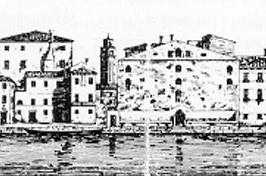
The Teatro San Angelo or Teatro Sant'Angelo was once a theatre in Venice which ran from 1677 until 1803.
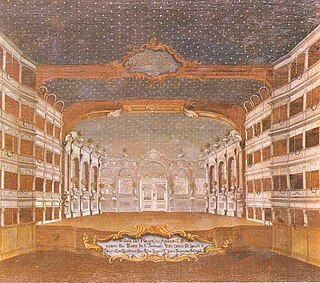
Teatro San Samuele was an opera house and theatre located at the Rio del Duca, between Campo San Samuele and Campo Santo Stefano, in Venice. One of several important theatres built in that city by the Grimani family, the theatre opened in 1656 and operated continuously until a fire destroyed the theatre in 1747. A new structure was built and opened in 1748, but financial difficulties forced the theatre to close and be sold in 1770. The theatre remained active until 1807 when it was shut down by Napoleonic decree. It reopened in 1815 and was later acquired by impresario Giuseppe Camploy in 1819. In 1853 the theatre was renamed the Teatro Camploy. Upon Camploy's death in 1889, the theatre was bequeathed to the City of Verona. The Venice City Council in turn bought the theatre and demolished it in 1894.

Sebastiano Biancardi, known by the pseudonym Domenico Lalli, was an Italian poet and librettist. Amongst the many libretti he produced, largely for the opera houses of Venice, were those for Vivaldi's Ottone in villa and Alessandro Scarlatti's Tigrane. A member of the Accademia degli Arcadi, he also wrote under his arcadian name "Ortanio". Lalli was born and raised in Naples as the adopted son of Fulvio Caracciolo but fled the city after being implicated in a bank fraud. After two years wandering about Italy in the company of Emanuele d'Astorga, he settled in Venice in 1710 and worked as the "house poet" of the Grimani family's theatres for the rest of his career. In addition to his stage works, Lalli published several volumes of poetry and a collection of biographies of the kings of Naples. He died in Venice at the age of 62.
Damiano Michieletto is an Italian stage director especially known for opera. He has staged productions at leading opera houses and festivals worldwide. His awards include the 2015 Laurence Olivier Award for the production of Mascagni's Cavalleria rusticana and Leoncavallo's Pagliacci at the Royal Opera House in London.
Signor Goldoni is a 2007 English-language opera by Luca Mosca to a libretto by Pierluigi Melega. Melega's English libretto concerns the playwright Carlo Goldoni and his characters, but also incorporates elements from Shakespeare's plays set in the Veneto; Othello, Romeo and Juliet, The Merchant of Venice and Two Gentlemen of Verona, with Shakespeare himself appearing.
Luca Mosca is an Italian composer. He is best known for his 2007 opera Signor Goldoni.
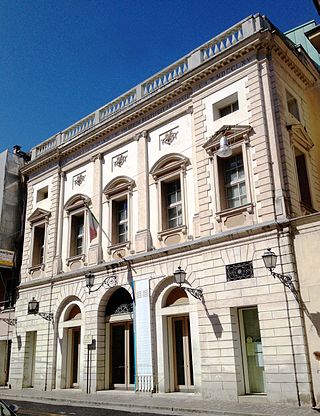
The Teatro Mario Del Monaco is an opera house and theatre in Treviso, Italy. It was previously known as the Teatro Onigo from 1692 to 1846, the Teatro Sociale from 1847 to 1930, and the Teatro Comunale from 1931 to 2011. In 2011, it was renamed in honour of the Italian tenor Mario Del Monaco who lived in Treviso from 1975 until his death in 1982. It is located in the historic centre of the city on the Corso del Popolo and since 2019 has been run by the Teatro Stabile del Veneto which also runs the Teatro Goldoni in Venice and the Teatro Verdi in Padua.

Maria Gabriella Zen is an Italian composer.
















